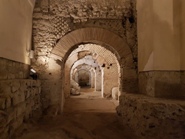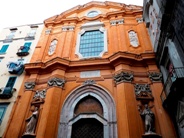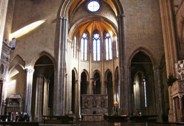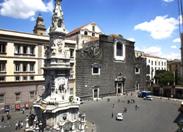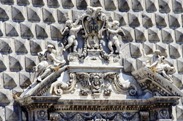
PRIVATE TOUR OF THE CHURCHES OF NAPLES AND UNDERGROUND NAPLES WITH AN ARCHAEOLOGIST
Details
PRIVATE TOUR OF THE CHURCHES OF NAPLES AND UNDERGROUND NAPLES WITH AN ARCHAEOLOGIST - 2 hours
DURATION: |
2 hours | |
PRICE: |
EUROS 300 | |
AVAILABILITY: | All-year-round | |
| A real English-speaking archaeologist at your disposal for 2 hours ENTRANCE FEES FOR THE SAN LORENZO UNDERGROUND ARE NOT INCLUDED | |
PRIVATE TOUR OF THE CHURCHES OF NAPLES AND UNDERGROUND NAPLES WITH AN ARCHAEOLOGIST - 2 hours
This private two-hour walking tour of the historic center of Naples is conducted by an English-speaking archaeologist and connoisseur of the history of art. This guided visit is divided into two parts: the first part takes place on the surface (along the streets of the city) and the second part in the underground Naples. On the surface you will visit the churches of Gesù Nuovo (the triumph of the Baroque in Naples), Santa Chiara and San Lorenzo (splendid examples of Italian Gothic). Below the church of San Lorenzo it is possible to visit Naples underground, the Greek and Roman Naples which was then buried and covered by more modern buildings.
The Gothic Naples is an important page of the history of the city because Carlo I d'Anjou becomes king of Sicily in 1266 thanks to the help of Pope Clement IV (also French). The new king transfers the capital of the kingdom from Palermo to Naples. Then, for a greater control of the population of Naples, Charles I d'Anjou uses religious leverage favoring the arrival in the city of various monastic orders among which the Franciscans and the Dominicans. In that period, therefore, the construction of the new Gothic churches symbolically represents the alliance between the monarchy of the kingdom and the clergy. And at that time Naples becomes a huge building site where castles, churches, noble residences were built: architects, sculptors, painters, craftsmen of all kinds from all over Europe will arrive in the new capital.
Very little of the Greek and the Roman Naples remains on the surface. Actually , the historic center of Naples, entirely overlapping the ancient city, has kept its regular ancient Greek urban planning, divided into 3 east-west platèiai (main roads) and about twenty north-south stenòpoi (secondary roads). The city spread for about 70 hectares and was surrounded by ravines. In addition it was bordered by mighty city walls in blocks of tufa of the V century b.C., several times restored between the IV century. B.C. and the V century A.D.
The wide agora, the main square in the Greek era, was cut in two parts by the median platèia, based on the current Via dei Tribunali. This is known above all for the presence of remains of buildings from the Roman era and certainly it reflects the previous Greek urban planning. The northern part of the Agora was marked by the presence of the Theater and the Odèion (theater for musical performances and mime). To the south of the Agora there was the great temple of the Dioscuri. The lower part of the Agora, instead, was narrower than the superior, and it was equipped with the Macellum, the covered market and the shops of the imperial era.
In the second part of the tour, your reach with your archaeologist the underground Naples through the church of San Lorenzo. At a depth of 4,5 meters you find first of all the medieval level: the Seggio del Popolo (Seat of the People). In that place representatives of the elected people gathered to administer justice at the time of the ducal city (VI-X century). Going down another 8 meters (12 meters deep in total) there is a paved road of the Neronian age (Nero 54 - 68 AD) that runs from north to south.
Along this road there are many shops, all built under the Macellum and above a great Greek wall.
Later this part of the Roman city was buried by a flood in the V century A.D. and then on the top of it an early Christian church was built.
WHY SHOULD YOU CHOOSE FOR THIS TOUR AN ARCHAEOLOGIST AND A CONNOISSEUR OF THE HISTORY OF ART?
Naples is certainly one of the richest cities of art in the world and its historic center is an open-air museum. Walking along the streets you can see historical buildings in every corner, Roman columns reused in medieval times, churches of every historical period.
Surrounded by deep natural ravines to the east and west, the sea to the south and hills to the north, over the centuries the Greek and Roman city has developed on itself. It is therefore possible to visit medieval and Renaissance Naples in the open air, but descending through tunnels at a depth of 12 meters, it is still possible - like a small Pompeii - to stroll along Roman roads that date back two thousand years. In some places you can even see Greek buildings of 2600 years ago, on which then the Roman buildings were built.
A tour in a place so rich in art and history requires an art history expert who is also an archaeologist and a connoisseur of the city.
N.B .: Tickets not included for the San Lorenzo underground.
This tour is not suitable for those suffering from claustrophobia.
THIS IS A PRIVATE DAY TOUR WITH A PRICE NOT BASED ON THE NUMBER OF PEOPLE TRAVELLING IN YOUR PARTY!
THIS TOUR WILL OPERATE RAIN OR SHINE, SO BE PREPARED FOR ALL WEATHER CONDITIONS.
THIS TWO-HOUR TOUR IN NAPLES COSTS EUROS 250. Tickets for the San Lorenzo underground ARE NOT INCLUDED.

